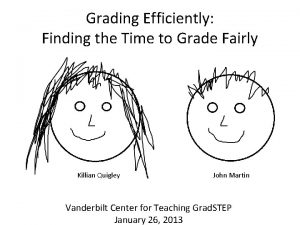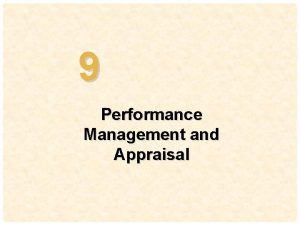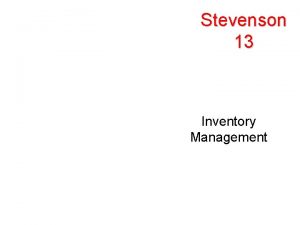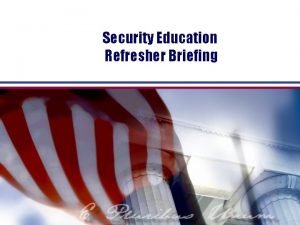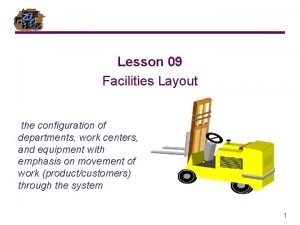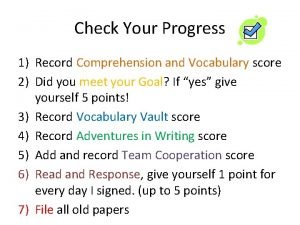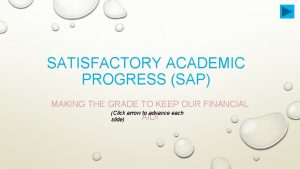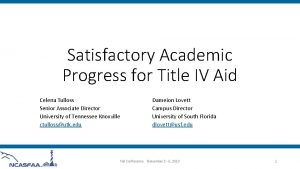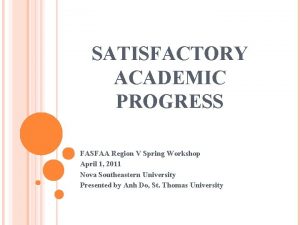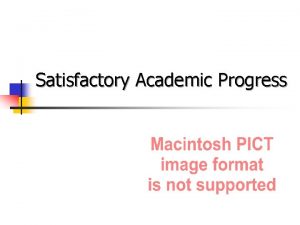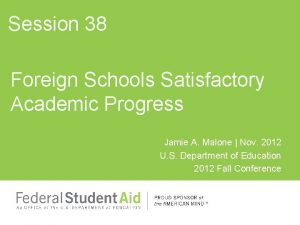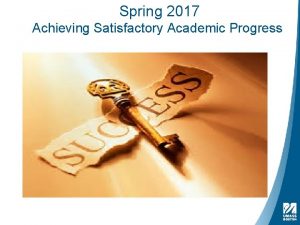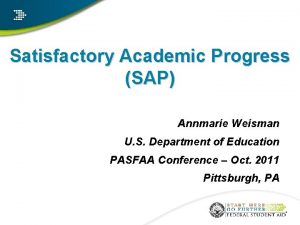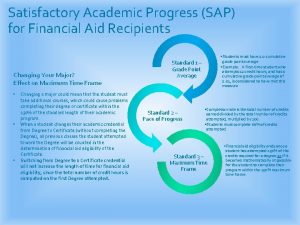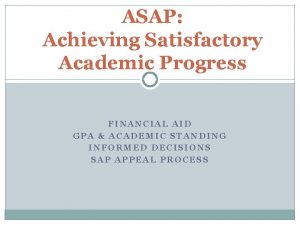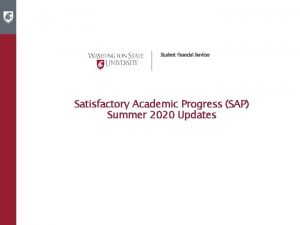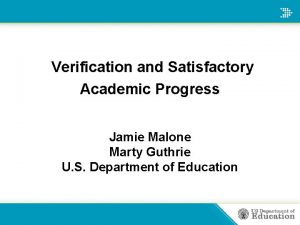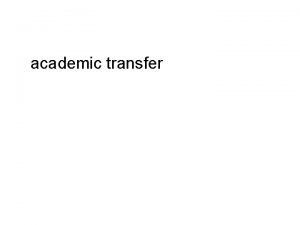Satisfactory Academic Progress Does your Policy make the




































- Slides: 36

Satisfactory Academic Progress: Does your Policy make the Grade? Presented by David Bartnicki Federal Training Officer david. bartnicki@ed. gov; 404 -974 -9312

SAP Compliance Concerns ü ü ü 2 Failure to develop a policy that meets minimum Title IV requirements Misalignment of pace of progression and maximum timeframe Applying a different policy than the official written SAP policy Failure to comply with the Program Integrity regulations, effective 7/1/2011 Failure to properly monitor and/or document satisfactory progress dit u a n e t p o t the n i y l t n e t s i s Con dings n i f w e i v e r and program

668. 34 – Satisfactory Academic Progress (SAP) • (a) Satisfactory academic progress policy. An institution must establish a reasonable satisfactory academic progress policy for determining whether an otherwise eligible student is making satisfactory academic progress in his or her educational program and may receive assistance under the title IV, HEA programs. 3

SAP Standards • Reasonable • Consistently applied • Applies to all Title IV programs – If not meeting SAP, not eligible for any TIV program – Cannot say eligible for Pell but not eligible for Loans • “ED provides the outline; schools fill in the details” – Schools have a lot of flexibility 4

“As Strict or Stricter” • Having an SAP policy “as strict or stricter” then other school policies refers to the actual measurements used to monitor qualitative and quantitative standards - GPA and pace • It does NOT refer to the frequency in which the school checks SAP – Therefore academics might check GPA every term but financial aid can check GPA for SAP purposes annually 5

Policy Q & A - Different Policies SAP-Q 9: Is an institution required to use the same SAP policy for all students? SAP-A 9: No, the policy must explain the qualitative (gradebased) and quantitative (time-related) standards the institution uses to check SAP; however, an institution is permitted to establish different SAP standards for different programs or categories (e. g. , full-time, parttime, undergraduate, and graduate students) which must be applied consistently to students in that category or program. 6

SAP Evaluation Items • At each formal SAP evaluation point, a school checks: 1. Qualitative measure • • Remedial coursework qualitative measure may be part of or separate from regular qualitative measure Qualitative measure for programs greater than 2 years 2. Quantitative measure (pace of progression) 3. Maximum timeframe 7

Qualitative Measure Definition: To access quality of academic work using standards measureable against a norm – Grades; work projects; etc. • Must be cumulative • May use a graduated or fixed standard • Can be more restrictive and have payment period measurements in addition to cumulative measures – Could have an overall cumulative program or school GPA and a semester GPA requirement 8

Policy Q & A - Remedial • SAP-Q 3: How are remedial courses treated for SAP purposes? • SAP-A 3: The institution's SAP policy should describe how remedial courses are treated. An institution may, but is not required to, include remedial coursework in determining pace. However, the school must evaluate remedial coursework under the qualitative factor, though it does not have to be part of the GPA. If not part of the GPA, the school must have some other measurement process to evaluate remedial coursework (passing courses, meeting course requirements, etc. ) 9

Policy Q & A – Programs > 2 yrs R-Q 2: How does the qualitative portion of a SAP review relate to the requirement for a student to have a GPA of at least 2. 0, or academic standing consistent with the institution’s requirements for graduation? R-A 2: …the Higher Education Act requires a specific qualitative review at the end of the student’s second academic year. In this context, we have interpreted the “second academic year” as the student being at the school for 4 semesters or 6 quarters, regardless of a student’s enrollment status. At that point, the student must have a GPA of at least a 2. 0 or its equivalent or have academic standing consistent with the institution’s graduation requirements. 10

Quantitative Measure Definition: To measure progress toward program completion • Must be cumulative • May use a graduated or fixed standard • Can be more restrictive and have payment period measurements in addition to cumulative measures – Could have an overall cumulative completion pace and a semester completion requirement 11

Quantitative Measure § Pace of progression required to make sure student completes within maximum time frame § Calculate the pace at which the student is progressing by § Dividing the cumulative number of hours the student has successfully completed by § The cumulative number of hours the student has attempted § For clock hours you are evaluating cumulative clock hours required to complete as expressed in calendar time 12

Max Timeframe • Limits of Maximum Timeframe – For undergraduate programs, must be no longer than 150% of published length of educational program – For gradate programs of study, school defines the maximum based upon length of program • Example: – Degree program requires 120 credits for completion – 120 x 150% = 180 attempted credits is maximum timeframe • Quantitative measure (tied to max timeframe) – 120 credits / 180 credits = 67% – Student must earn 67% of credit hours attempted 13

Max Timeframe • Must be measured at each evaluation point – Student is ineligible at the evaluation point where indicated will exceed max timeframe NOT at the point when they actually reach the max timeframe • Example • At end of payment period (SAP evaluation checkpoint) student has attempted 160 credit hours out of a possible 180 credit hours allowed under max timeframe but has 25 hours left to earn to complete his degree. • The student is not meeting SAP due to exceeding the max timeframe because he has more hours to earn than what is allowed to graduate within the max timeframe 10/29/10 Federal Register reminds schools that 150% maximum timeframe can be appealed 14

Checking SAP § Student’s SAP evaluations, whether each payment period, annually or less often than each payment period, must occur at the end of a payment period § Official evaluation period cannot be less than a payment period 15

SAP – Clock Hours • Evaluation “at end of payment period” – Schools have 3 options 1) At the point when the student’s scheduled clock hours for the payment period have elapsed, regardless of whether the student attended them; or 2) At the point when the student has attended the scheduled clock hours; or 3) At the point when the student successfully completes the scheduled clock hours for that payment period 16 School must establish one review option for a program; cannot start with one option and then after the first review, switch to a different option for that cohort of students.

SAP – Cl. Hr. Pace Example Background • • • 1200 clock hour program, 40 weeks Payment periods – 450 hrs/15 wks; 450/15; 300/10 Student scheduled 30 hours per week Max timeframe is 150% of 40 weeks = 60 weeks 67% completion rate to measure pace Evaluate SAP each payment period Program Integrity Q & A website – SAP Question R-Q 9 http: //www 2. ed. gov/policy/highered/reg/hearulemaking/2 009/integrity-qa. html 17

SAP – Cl. Hr. Pace Example Option #3 – Successfully completed hours • At 450 successfully completed hours, 600 scheduled hours elapsed • 450/600 = 75% or, as expressed in calendar time, 15 weeks/20 weeks = 75%. – Both items checked according to max timeframe • Because student has successfully completed both the hours and the weeks in the payment period, the second disbursement could be made at this time • Next review is at 900 successfully completed hours 20

Policy Q & A – Non-Accepted Credits SAP-Q 6: SAP regulations require credit hours accepted toward student’s program count as both attempted and completed when calculating pace for SAP. Can an institution’s policy include non-accepted credits as attempted credits for purposes of these calculations? SAP-A 6: Yes. The treatment of these credits would be up to the institution. The SAP regulations do not address non-accepted credits. – May refer to transfer credits or credits earned in other academic programs at your school 22

Warning Period § For an institution that chooses to evaluate SAP at the end of each payment period, a “financial aid warning” status may be used § Student may continue to receive Title IV aid for one payment period § No appeal necessary § Possible for student to receive more than one warning period during academic career just NOT consecutively 23

Monitoring SAP • If measure each payment period – – The payment period following a payment period in which the student did not make SAP, the school may: • Place the student on Financial Aid Warning; or • Place the student on Financial Aid Probation (with proper appeal approvals); or – If on Financial Aid Warning § After ONE payment period, student must: § Make SAP; or § May be placed on probation after successful appeal 24

Monitoring SAP • If evaluate SAP annually or less often than each payment period §The payment period following a payment period in which the student did not make SAP, the school may: § Place the student on Financial Aid Probation (with proper appeal approvals) § “Annually” means a 12 -month period § An institution is expected to review a student’s SAP at least once every 12 months 25

Probation § To be placed on Probation, a student must: § Appeal and have it approved by the school; AND § Student expected to be making SAP in next payment period; OR § Be successfully following an academic plan designed to ensure student will be able to meet SAP by a specific point in time § Not required to develop academic plans § Can set conditions on developing plans 26

Probation • A student on Probation may only receive Title IV funds for ONE payment period • A student on Probation may not receive Title IV funds for the subsequent payment period UNLESS: – Student is now making SAP; or – Institution determines student met requirements specified by the school in the academic plan and student still covered by academic plan 27

Policy Q & A – Academic Plans ACP-Q 2: What is the status of a student who has completed the probationary payment period and who is continuing to receive aid by meeting the requirements of the student’s academic plan? ACP-A 2: A student who has been reinstated to eligibility under an academic plan and is making progress under that plan is considered to be an eligible student. • May be evaluated at the same time as other TIV recipients or at more frequent periods based on plan 28

Policy Q & A – Academic Plans ACP-Q 3: Can the academic plan be the same for all students or the same by student categories or must the plan be created individually for each student? ACP-A 3: According to the regulations, the academic plan is developed by the institution and the student individually. It is possible that a general plan could be used for students in a similar circumstance and then customized, as needed, for each student’s particular circumstance. 29

Policy Q & A – Academic Plans ACP-Q 4: Must the academic plan be mathematically set to graduate student within 150% time frame? ACP-A 4: The academic plan must be designed to ensure that the student is able to meet the institution's satisfactory academic progress standards by a specific point in time. In some cases, this could mean that the maximum timeframe would be extended based on the student's approved appeal. 30

Policy Q & A - Probation PROB-Q 4: How many times may a student be placed on probation for failing to meet SAP standards? PROB-A 4: A student may be placed on probation for one payment period per appeal. It is possible that a student could be placed on probation more than once in his or her academic career. 31

Appeals § Process by which student who is not meeting school’s SAP policy petitions for reconsideration of eligibility for Title IV § Policy must specify the conditions under which a student may appeal § Appeal must include: § Why the student failed to make SAP; AND § What has changed that will allow the student to make SAP at the next evaluation 32

Policy Q & A – Appeal Docs APP-Q 2: What documentation is required for a student appeal? APP-A 2: That is up to the institution. An institution may choose to request additional documentation when a particular student circumstance warrants it. The institution may decide to require more extensive documentation on an initial appeal and an update statement on a subsequent appeal. 33

Policy Q & A - Amnesty APP-Q 4: May an institution’s SAP policy include automatic “academic amnesty” in certain circumstances, such as, after a student has not attended for a certain number of payment periods or years? APP-A 4: No. The regulations permit use of the automatic financial aid warning status for institutions that review SAP at each payment period. No other status may be granted automatically. A successful appeal is needed to grant financial aid probation status or to develop an academic plan. 34

Appeal Notification § Notification to students § Must notify student of results of SAP review that impacts student’s eligibility for Title IV aid § If institution has an appeal process, must describe the specific elements required to appeal SAP § May specify how often and how many appeals are allowed § If institution does not have an appeal process, must describe how a student who has failed SAP can reestablish eligibility for Title IV aid 35

Resources/References • FSA Assessments, Student Eligibility section: – http: //ifap. ed. gov/qahome/qaassessments/studentelig. html § 668. 16, 668. 34 (SAP) § 13/14 FSA HDBK Vol. 1, Chapter 1 § Electronic Announcement - September 2, 2011 § Policy Q & A Webpage on program integrity regs § http: //www 2. ed. gov/policy/highered/reg/hearulemaking/20 09/integrity-qa. html § Upper right-hand side of IFAP 36

SAP Compliance Concerns ü Failure to develop a policy that meets minimum Title IV requirements ü Misalignment of pace of progression and maximum timeframe ü Applying a different policy than the official written SAP policy ü Failure to comply with the Program Integrity regulations, effective 7/1/2011 ü Failure to properly monitor and/or document satisfactory progress Does your Policy make the Grade? 37

QUESTIONS? 38

“NEW” - Training Feedback To ensure quality training we ask all participants to please fill out an online session evaluation • Go to http: //s. zoomerang. com/s/David. Bartnicki – Evaluation form is specific to David Bartnicki • This feedback tool will provide a means to educate and inform areas for improvement and support an effective process for “listening” to our customers • Additional concerns about training can be directed to joann. borel@ed. gov 39
 Physical progress and financial progress
Physical progress and financial progress Rating committee performance appraisal
Rating committee performance appraisal Fairly satisfactory grade
Fairly satisfactory grade Apprasol
Apprasol What would a satisfactory moral theory be like
What would a satisfactory moral theory be like Satisfactory needs improvement
Satisfactory needs improvement Facility planning objectives
Facility planning objectives Piddling manufacturing assembles security monitors
Piddling manufacturing assembles security monitors Satisfactory shredder
Satisfactory shredder Facility layout
Facility layout Abc classification system for inventory
Abc classification system for inventory Satisfactory slide glitch
Satisfactory slide glitch Usc academic integrity policy
Usc academic integrity policy Jennifer buchanan fsu
Jennifer buchanan fsu Check my progress vocabulary check
Check my progress vocabulary check American progress painting what does the woman represent
American progress painting what does the woman represent Give us your hungry your tired your poor
Give us your hungry your tired your poor Does your walk match your talk
Does your walk match your talk Make the lie big, make it simple
Make the lie big, make it simple Go make a difference
Go make a difference Make the lie big, make it simple
Make the lie big, make it simple Hình ảnh bộ gõ cơ thể búng tay
Hình ảnh bộ gõ cơ thể búng tay Ng-html
Ng-html Bổ thể
Bổ thể Tỉ lệ cơ thể trẻ em
Tỉ lệ cơ thể trẻ em Chó sói
Chó sói Thang điểm glasgow
Thang điểm glasgow Chúa yêu trần thế
Chúa yêu trần thế Môn thể thao bắt đầu bằng từ đua
Môn thể thao bắt đầu bằng từ đua Thế nào là hệ số cao nhất
Thế nào là hệ số cao nhất Các châu lục và đại dương trên thế giới
Các châu lục và đại dương trên thế giới Công thức tính thế năng
Công thức tính thế năng Trời xanh đây là của chúng ta thể thơ
Trời xanh đây là của chúng ta thể thơ Cách giải mật thư tọa độ
Cách giải mật thư tọa độ Làm thế nào để 102-1=99
Làm thế nào để 102-1=99 Phản ứng thế ankan
Phản ứng thế ankan Các châu lục và đại dương trên thế giới
Các châu lục và đại dương trên thế giới


